
HistoryKeystone Renovation / Alternative EnergyKeystone RenovationThe old Keystone church and parsonage were a sad sight to look at in 1980 when Barbara Shelton was considering purchasing the buildings and land. The chimneys had tumbled down, windows and doors were non-existent, walls were crumbling, and all the buildings were open to the weather. Twenty-seven years of abandonment had taken its toll on the structures. The interior of the old church had been used as a “pigeon hunting paradise” for many years. Dirt, dried grass, and shotgun shells covered the floor from the height of the stage area all the way out the door. There were holes in the house floor and someone had removed part of the church’s stage, plus all the baseboard moldings.
The renovation work was quite a challenge for Barbara and Chuck. Every surface, both inside and out, had to be either replaced or repaired. The initial work entailed removing dangerous things, such as the hanging chimney inside the church that was ready to fall on someone’s head. The outside part of the chimney was already gone and can only be seen in historical pictures. Fortunately, the stone structures of the former parsonage and old church were in pretty good shape. The house was the first renovation project, starting from the roof down. Outdoor projects included replacing cedar shingles, laying a brick chimney, putting in windows and doors, and doing exterior patch and repair work. Interior renovation included shoveling out debris; sheetrocking the ceiling and interior walls; plastering damaged rock walls; laying floor underlayment, tile, and carpeting; and painting the walls, ceilings, and trim.
The stone shed, built in 1935, had deteriorated badly over the years. The roof was completely gone, stones had fallen off or disintegrated, and the mortar between the rocks was almost non-existent. The shed was rebuilt from the ground up, but they mortared the rocks that were still in place. The old Keystone Church was mainly used for storage and as Chuck’s painting studio. Barbara and Chuck made the decision to open an art gallery and fossil museum in 1989 and renovation began in earnest. The east roof was opened up and a skylight for natural light was installed. Exterior renovation began with window sash installation and cement work on the exterior stones.
Finally, the dirtiest job was tackled when the old yellow pine floor was repaired, swept, mopped, and varnished. The Keystone Gallery opened on Labor Day weekend in 1991. After the opening of the gallery, continuing upgrades and improvements have been made.
Barbara purchased a beautiful, limestone sculpture of a buffalo cow and calf from noted Kansas sculptor Pete Felten (shown at top right), adding an artistic flair to the front of the property. Family friends Martin Brungardt and Rufus Stephens (bottom right) dug out a hole for the base of the sculpture, then Barbara laid in the limestone blocks. Other exterior improvements waited until 1995 when US 83 Highway was closed to traffic and detoured to another highway. This provided an opportunity to reshingle the gallery. The last time the wood shingles were replaced was right after WWII.
Chuck and Barbara continue to make new changes to the gallery every year. A visitor from fifteen years ago would hardly recognize it!
Alternative Energy at Keystone
In 1985, they put up a small windcharger and started with a 12-volt trouble light and a single car battery. Later, a bank of golf cart batteries provided electric storage for prolonged use. In 1988, they upgraded to a higher wattage (500 watts) windcharger and also purchased new batteries. Since the house and gallery had never been wired, the 12-volt electrical system was fairly easy to do, much like a stationary recreational vehicle. The switches and light fixtures are the same as a standard house, but the outlets and light bulbs are 12-volt. There are many direct current products available and inverters (electrical devices that change 12-volt DC to 120-volt AC current) can be used for other applications.
As with any alternative energy setup, a backup power unit is needed. When power is low, a small gas-powered generator is used to charge the batteries. The sun shines and the wind blows a lot in Kansas, so the gas generator is seldom used. In the winter months, when sunny days are short and ice sometimes covers the windcharger propeller and the solar panels, the generator is used more often. Another use of alternative energy at Keystone is solar heat. A greenhouse provides supplemental heat during winter months and allows an extended growing season for the outdoor garden in both spring and fall. ©2015 Keystone Gallery / Photos © Barbara Shelton unless otherwise noted |




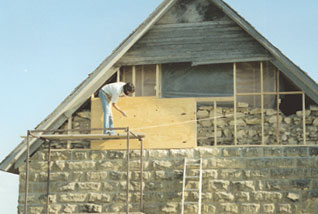

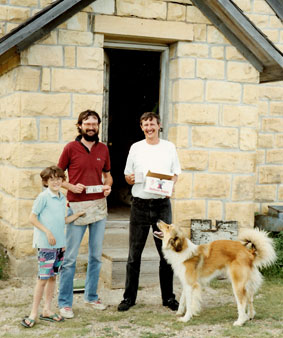

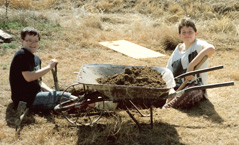
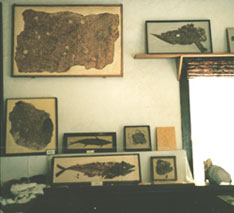
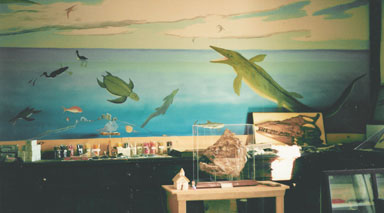

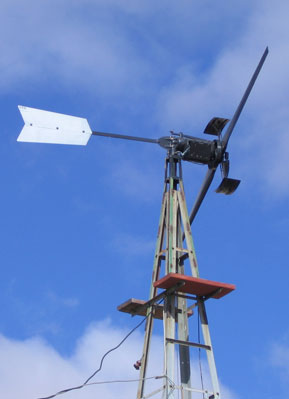 The Keystone Church and parsonage were never connected to the electric power grid. When Chuck and Barbara first started working on the place, all work was done with hand tools. At night, they would use kerosene lamps and flashlights for reading and finding things in the dark.
The Keystone Church and parsonage were never connected to the electric power grid. When Chuck and Barbara first started working on the place, all work was done with hand tools. At night, they would use kerosene lamps and flashlights for reading and finding things in the dark.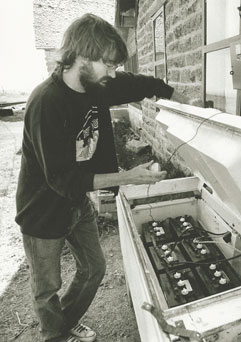
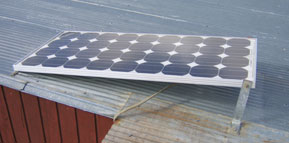 Because of the continuous modification and upgrade of appliances and the addition of computers, televisions, and other energy-using items, Barbara and Chuck took the leap into solar energy to supplement their wind power system. Starting with a 100-watt panel, more solar panels were added over the years to upgrade the system as the need arose.
Because of the continuous modification and upgrade of appliances and the addition of computers, televisions, and other energy-using items, Barbara and Chuck took the leap into solar energy to supplement their wind power system. Starting with a 100-watt panel, more solar panels were added over the years to upgrade the system as the need arose.